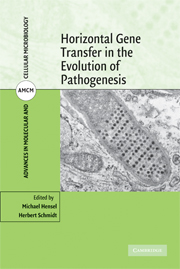Book contents
- Frontmatter
- Contents
- Preface
- Contributors
- PART I Theoretical Considerations on the Evolution of Bacterial Pathogens
- PART II Mobile Genetic Elements in Bacterial Evolution
- 3 Phage-bacterium Co-evolution and Its Implication for Bacterial Pathogenesis
- 4 The Role of Bacteriophages in the Generation and Spread of Bacterial Pathogens
- 5 Genomic Islands in the Bacterial Chromosome – Paradigms of Evolution in Quantum Leaps
- PART III Paradigms of Bacterial Evolution
- PART IV Interkingdom Transfer and Endosymbiosis
- Index
- References
3 - Phage-bacterium Co-evolution and Its Implication for Bacterial Pathogenesis
from PART II - Mobile Genetic Elements in Bacterial Evolution
Published online by Cambridge University Press: 16 September 2009
- Frontmatter
- Contents
- Preface
- Contributors
- PART I Theoretical Considerations on the Evolution of Bacterial Pathogens
- PART II Mobile Genetic Elements in Bacterial Evolution
- 3 Phage-bacterium Co-evolution and Its Implication for Bacterial Pathogenesis
- 4 The Role of Bacteriophages in the Generation and Spread of Bacterial Pathogens
- 5 Genomic Islands in the Bacterial Chromosome – Paradigms of Evolution in Quantum Leaps
- PART III Paradigms of Bacterial Evolution
- PART IV Interkingdom Transfer and Endosymbiosis
- Index
- References
Summary
INTRODUCTION
Virulent phages such as Escherichia coli phage T4 are professional predators of bacteria. It is believed that this predator-prey relationship resulted in an evolutionary arms race in which bacteria developed anti-predation strategies against phages such as loss of receptor structures, restriction-modification systems, and abortive infection mechanisms. Temperate phages can lyse the bacterial host or alternatively integrate their DNA into the bacterial chromosome. As judged from the analysis of bacterial genomes, about a third of the bacteria might contain a prophage sequence. Temperate phages had thus a great impact on bacterial chromosome structure in general and the evolution of bacterial pathogenicity in special.
THEORETICAL FRAMEWORK FOR PHAGE-BACTERIUM INTERACTION
The peculiar life style of temperate phages makes them model systems to address a number of fundamental questions in evolutionary biology. The viral DNA undergoes different selective pressures when replicated during lytic infection cycles as compared to prophage DNA maintained in the bacterial genome during lysogeny. Darwinian considerations along with the selfish gene concept lead to interesting conjectures (Boyd and Brüssow, 2002; Brüssow and Hendrix, 2002; Brüssow et al., 2004; Canchaya et al., 2003, 2004; Lawrence et al., 2001). One could anticipate that the prophage decreases the fitness of its lysogenic host by at least two processes: first by the metabolic burden to replicate extra DNA and second by the lysis of the host after prophage induction. To compensate for these disadvantages one has to invoke the explanation that temperate phages encode functions that increase the fitness of the lysogen.
- Type
- Chapter
- Information
- Publisher: Cambridge University PressPrint publication year: 2008
References
- 3
- Cited by

